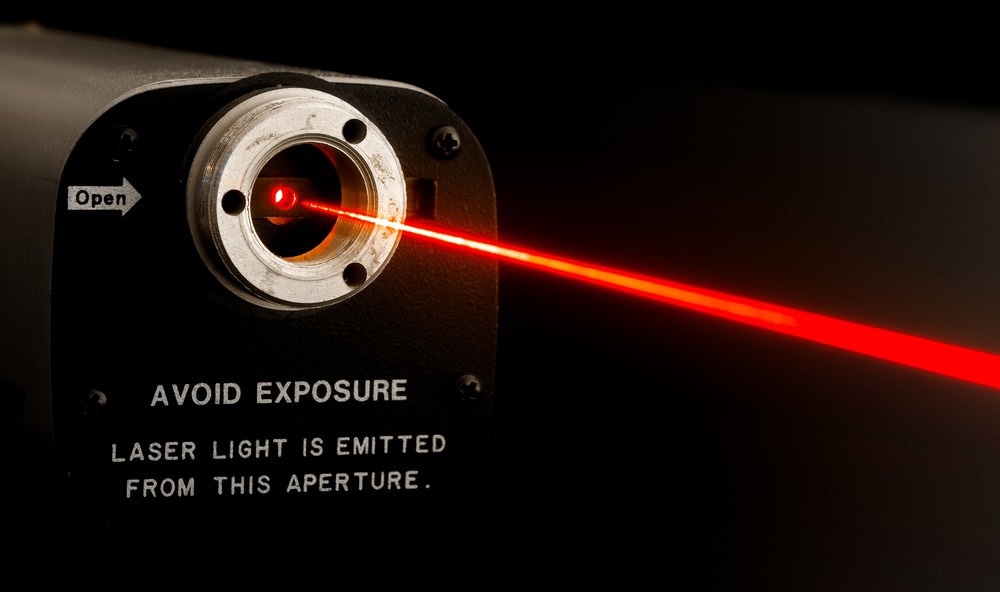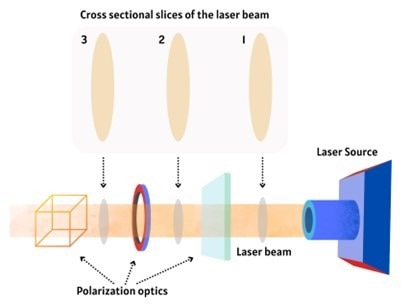New research efforts published in the journal Nature Communications have used the concepts of spatial state tomography to measure the detailed evolution of laser beam parameters as a collection of temporally, spectrally, and polarization-resolved spatial state density matrices. An in-depth understanding of the evolution of these laser features paves the way for more efficient optical technology.

Image Credit: Doug McLean/Shutterstock.com
New Technique for Resolving the Spatial Tomography of Light
Studying phenomena in laser dynamics, telecommunications, and nonlinear optics requires measuring optical beams' polarization, frequency spectrum, temporal dynamics, and spatial resolution complex amplitude.
Data is usually carried by these beams, either in space through complex written wavefronts, or in time through pulse envelopes that have been specifically designed.
Additional information channel multiplexing is possible using the spectral and polarization dimensions. The laser cavities' innate properties can give rise to altered states of light.

Figure 1: Diagram showing a laser light beam propagating from a laser source. Difference cross-sectional slices of the laser beam over time is denoted by 1,2 and 3. Image Credit: Ilamaran Sivarajah
Cross-Section of a Laser Beam
The changing parameters of a propagating beam can be described with the help of Figure 1. When the laser light exits the source and propagates in freespace, the evolution of its parameters can be viewed as slices of its cross-section separated by time.
From slice 1 to 3 in Figure 1, polarization, frequency, intensity profile and other critical parameters could change. Each snapshot can be analyzed to infer how a particular property may have evolved.
Optical beams can comprise several incoherent spatial fields with varying time delays and many spectral profiles. When the laser beam is made up of several spatial components, their coherence, wavelength, and frequency are extremely difficult to characterize.
Characterizing Beam Parameters
While several experimental techniques have been developed to assess this evolution, there have been shortcomings in various assumptions and references in such schemes. For example, traditional optical beam analysis methods either use an external reference or operate on a self-referencing concept to recover the optical signal properties.
Although this method can recover the spatial intensity, phase, and coherence, the spectral bandwidth and range of wavelengths that can be explored are constrained by the limitations of the available optoelectrical components.
The modal analysis method profiles single-wavelength wavefronts and dynamic monitoring of laser light at a camera speed. In many cases, there is no prior knowledge or the beam does not have a single mode that may be used as a suitable reference.
For instance, even with ubiquitous optical sources, the spatial modes of the beam often occupy spectrally unique and distinct places. As a result, no single spatial component can be used as a suitable reference across the whole spectral range.
In the widening field of applications spanning from imaging to linear and nonlinear Spatio-temporal beam-shaping, the diversity of components conveyed by the beam makes decoding the complete information particularly challenging.
Developing a Method to Resolve the Spatial Tomography of Light
In a new concept, an optical beam in space has been created, along with its temporal, spectral, and polarization characteristics, using a high-dimensional spatial model of Stokes polarimetry.
Hundreds of spectral slices are typically acquired in spatial and temporal dimensions for the two polarizations. This is accomplished in a highly parallel manner using polarization optics (shown in Figure 1), an oscilloscope, and a spectrometer. Two spatial light modulators (SLM) and a single-pixel fiber-coupled detector are used to carry out the spatial projective measurements.
The entire measurement interferes with all the potential spatial components that could exist within the projection. Each projection measurement is resolved after interfering between two possible spatial modes of the unknown beam.
A class of optical beams challenging to analyze with current methods is represented by a vertical-cavity surface-emitting laser (VCSEL). This source is spatially, spectrally, and temporally fascinating.
By examining the beam of a VCSEL diode, the new technique was experimentally demonstrated. VCSEL allows several mutually incoherent spatial modes within the beam and is easily modulated in time.
As described above, experimental techniques were implemented to dissect and reconstruct the beam with optics and detectors. Spatio-temporal and Spatio-spectral analyses are carried out to investigate the beam properties of the VCSEL carefully.
Discussion and Outlook
Concepts of spatial state tomography were used to measure a comprehensive description of an unknown beam as a collection of spectrally, temporally, and polarization-resolved spatial state density matrices.
Even when fields spectrally or temporally overlap, each density matrix slice resolves the spatial complex amplitude of numerous mutually incoherent fields. This displays the spectral or temporal evolution of these fields over several slices.
Proof-of-concept tests looked at the complex spatiotemporal and spectral output of a modulated VCSEL diode, a class of optical beams that are challenging to analyze using current methods.
A bottleneck in a rising range of consumer, medical, automotive, sensing, and imaging applications requires a complete characterization of such laser sources. These applications, as well as many others where a complete understanding of the beam is essential, such as laser engineering, optical communication in fibers and free space, quantum information, and remote sensing, can all benefit from the knowledge gained through this technique.
References and Further Reading
Wright, L., Christodoulides, D. & Wise, F. (2015) Controllable spatiotemporal nonlinear effects in multimode fibers. Nature Photon 9, 306–310. https://doi.org/10.1038/nphoton.2015.61
Booth, M. (2014) Adaptive optical microscopy: the ongoing quest for a perfect image. Light Sci Appl 3, e165. https://doi.org/10.1038/lsa.2014.46
Plöschner, M., Morote, M.M., Dahl, D.S. et al. (2022) Spatial tomography of light resolved in time, spectrum, and polarization. Nat Commun 13, 4294. https://doi.org/10.1038/s41467-022-31814-2
Disclaimer: The views expressed here are those of the author expressed in their private capacity and do not necessarily represent the views of AZoM.com Limited T/A AZoNetwork the owner and operator of this website. This disclaimer forms part of the Terms and conditions of use of this website.